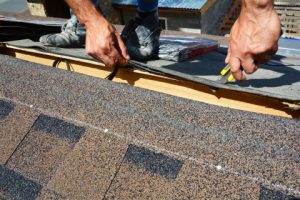If you have a sloped roof, you should have an underlayment, even if you have a low-sloping roof. This layer (which is the layer placed directly on the deck of your roof) provides further protection to your home. Today, we’re going to talk all about underlayments, including what they are and why we use them, the kinds of underlayments that are available on the market, when underlayments can fail, and, finally, our roofing services — Red Dog's Roofing provides roofing installations and replacement services for folks throughout Massachusetts.  Underlayments can be created from a variety of materials, including all of the following: Asphalt felt paper: This thin, black paper is especially common for residential roofing. Asphalt felt paper can be applied to steep-slope roofs in order to improve their weatherproof qualities. Asphalt felt paper comes in various weights, including 15-pound and 30-pound felts. 30-pound felt is more protective since asphalt felt paper isn’t completely waterproof (it’s only water resistant). Rubberized asphalt: Rubberized asphalt is, well, rubbery. This form of underlayment provides even more resistance to moisture, and it can provide more traction for roofers. Rubberized asphalt is often created with an adherent face, which ensures that the asphalt underlay sticks to the roof deck. Rubberized asphalt is a popular option for metal roofing, since it can mitigate some of the higher temperatures that metal can create. Non-bitumen synthetic material: Non-bitumen synthetic material underlays are rather new to the roofing industry, and there’s still debate as to their validity as a roofing felt. However, non-bitumen synthetic material underlays are strong, they offer excellent moisture protection, and they can improve traction for roofers. Check with your roofer to see if non-bitumen synthetic material underlays make sense for your roof, and be sure to ask if this underlay will keep your roof qualified for a warranty from your roofing-material manufacturer.
Underlayments can be created from a variety of materials, including all of the following: Asphalt felt paper: This thin, black paper is especially common for residential roofing. Asphalt felt paper can be applied to steep-slope roofs in order to improve their weatherproof qualities. Asphalt felt paper comes in various weights, including 15-pound and 30-pound felts. 30-pound felt is more protective since asphalt felt paper isn’t completely waterproof (it’s only water resistant). Rubberized asphalt: Rubberized asphalt is, well, rubbery. This form of underlayment provides even more resistance to moisture, and it can provide more traction for roofers. Rubberized asphalt is often created with an adherent face, which ensures that the asphalt underlay sticks to the roof deck. Rubberized asphalt is a popular option for metal roofing, since it can mitigate some of the higher temperatures that metal can create. Non-bitumen synthetic material: Non-bitumen synthetic material underlays are rather new to the roofing industry, and there’s still debate as to their validity as a roofing felt. However, non-bitumen synthetic material underlays are strong, they offer excellent moisture protection, and they can improve traction for roofers. Check with your roofer to see if non-bitumen synthetic material underlays make sense for your roof, and be sure to ask if this underlay will keep your roof qualified for a warranty from your roofing-material manufacturer.
What Are Roofing Underlayments?
As we mentioned, roofing underlayments (also called felt) are your home’s last line of defense, since they’re applied directly to the deck of your roof. Underlayments are pretty simple in concept. They’re strips of fabric or paper that are laid one over another (with overlap varying to meet the grade requirements of your roof slope). Like shingles, underlayments overlap cascading downward to keep water flowing off the roof with gravity. Underlayments can be fastened to a roof with staples or nails, although plastic capped nails are preferred, since they’re better at keeping moisture from penetrating your roof deck.Why Should We Use Them?
Underlayments serve a few purposes. First and foremost, they wick water away from the deck of your home. While shingles, metal roofing, and slate do a decent job at keeping water from touching the envelope of your home, underlayments provide further protection. This final form of waterproofing is especially important in storms that produce high-wind, as well as precipitation, since the wind can force water upslope — rendering your shingles useless. Underlayments are also helpful for roofers. Normally, roofing is rather dangerous. It’s difficult to navigate a highly sloped surface. Fortunately, roofing materials, like shingles, are easier to walk on then slick plywood. Underlayment also has more texture than plywood. That makes it easier for your roofer to get to work, and it makes the work environment far safer. Finally, underlayments may be fire resistant. Although some underlayments are as likely to catch fire as the plywood upon which they sit, other underlayments are fire resistant. If you’re concerned about fire safety for your home, talk to your roofer to ensure that they install an underlayment that’s designed to mitigate the odds of a house fire.What Are Some Underlayment Materials?
 Underlayments can be created from a variety of materials, including all of the following: Asphalt felt paper: This thin, black paper is especially common for residential roofing. Asphalt felt paper can be applied to steep-slope roofs in order to improve their weatherproof qualities. Asphalt felt paper comes in various weights, including 15-pound and 30-pound felts. 30-pound felt is more protective since asphalt felt paper isn’t completely waterproof (it’s only water resistant). Rubberized asphalt: Rubberized asphalt is, well, rubbery. This form of underlayment provides even more resistance to moisture, and it can provide more traction for roofers. Rubberized asphalt is often created with an adherent face, which ensures that the asphalt underlay sticks to the roof deck. Rubberized asphalt is a popular option for metal roofing, since it can mitigate some of the higher temperatures that metal can create. Non-bitumen synthetic material: Non-bitumen synthetic material underlays are rather new to the roofing industry, and there’s still debate as to their validity as a roofing felt. However, non-bitumen synthetic material underlays are strong, they offer excellent moisture protection, and they can improve traction for roofers. Check with your roofer to see if non-bitumen synthetic material underlays make sense for your roof, and be sure to ask if this underlay will keep your roof qualified for a warranty from your roofing-material manufacturer.
Underlayments can be created from a variety of materials, including all of the following: Asphalt felt paper: This thin, black paper is especially common for residential roofing. Asphalt felt paper can be applied to steep-slope roofs in order to improve their weatherproof qualities. Asphalt felt paper comes in various weights, including 15-pound and 30-pound felts. 30-pound felt is more protective since asphalt felt paper isn’t completely waterproof (it’s only water resistant). Rubberized asphalt: Rubberized asphalt is, well, rubbery. This form of underlayment provides even more resistance to moisture, and it can provide more traction for roofers. Rubberized asphalt is often created with an adherent face, which ensures that the asphalt underlay sticks to the roof deck. Rubberized asphalt is a popular option for metal roofing, since it can mitigate some of the higher temperatures that metal can create. Non-bitumen synthetic material: Non-bitumen synthetic material underlays are rather new to the roofing industry, and there’s still debate as to their validity as a roofing felt. However, non-bitumen synthetic material underlays are strong, they offer excellent moisture protection, and they can improve traction for roofers. Check with your roofer to see if non-bitumen synthetic material underlays make sense for your roof, and be sure to ask if this underlay will keep your roof qualified for a warranty from your roofing-material manufacturer. When Do Underlayments Fail?
Underlayments endure much of the same stresses as your other roofing materials. While your shingles are your first line of defense, underlayments still have a burden to bare. And if the weather is harsh, your underlayments can get damaged. Underlayments can eventually deteriorate due to ultraviolet light exposure, high-wind, moisture, and foot traffic. However, if the rest of your roof works as it should, your underlayment should last just as long as your roofing material.Count on Red Dog’s Roofing for Roofing Services
A Red Dog roof is a roof that you can rely on. We’re roofing experts, and we work with all sorts of roofing materials. Have a sloped roof? We can work on your shingles, shakes, slate, or metal to make sure that it’s ready for whatever the seasons can throw at it — and of course, we can utilize an underlayment to provide further protection for your roof. If you have a flat roof or low-incline roof, we can help you out too — we work on rubber roofs, TPO roofing, PVC roofing, modified bitumen roofing, torch-down roofs, and roof coatings. We’ll let you know if you need an underlayment for your particular roof style. Ready to get started? Schedule an appointment to have your roof built, repaired, or replaced today! We provide roofing services for folks throughout Fitchburg, Leominster, Gardner, Westminster, Lunenburg, Lancaster, Ashburnham, Princeton, and Sterling.Tags
Subscribe to Red Dog's Roofing's Blog






Comments